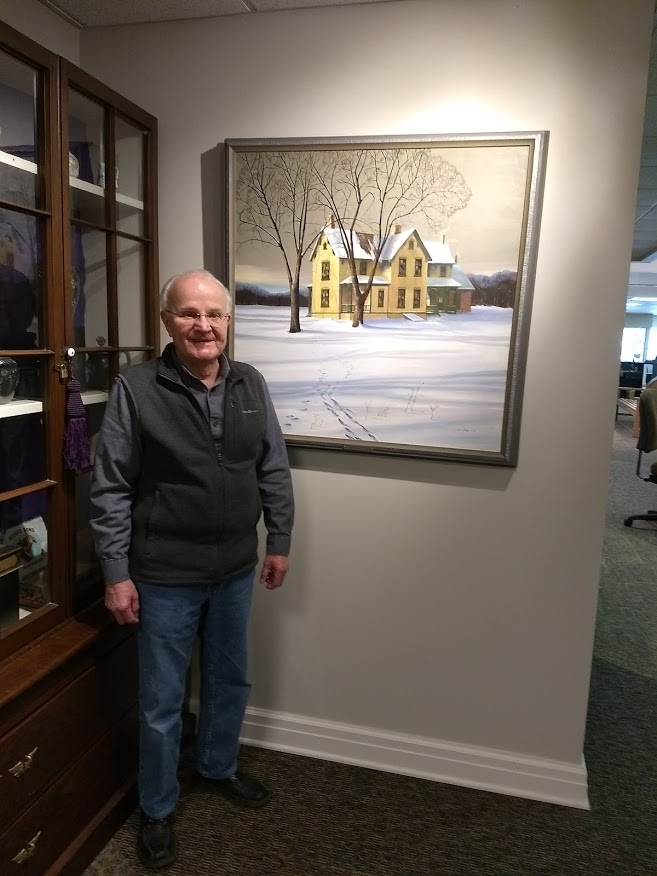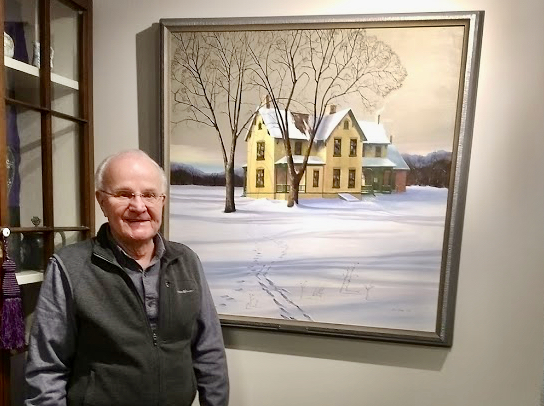Editor’s note: the following information has been submitted for publication by the Hoard Historical Museum and is written by one of its staff members, Linda Ager.
The Mary Hoard Art Show is returning to the Hoard Historical Museum for its 60th year after a two-year hiatus due to COVID-19.
Bob Hase, who was instrumental in helping Mary Hoard create the first art show in 1961, said the return of the show is important to both artists and to people who come to see the show. Hase is an artist and taught art in the Fort Atkinson school district for 40 years before retiring in 1997.
Hase, 86, will be recognized this year with an exhibit featuring a variety of his artwork, including paintings of historical local buildings, abstracts, images of the 35-foot sculpture called “Flame of Friendship” that was designed for the Fireside Dinner Theatre, and Styrofoam pumpkins painted for his granddaughter, Emily Cole, as she was growing up.
Part One of the art show, for kindergarten through middle school, runs Wed., March 30, to Sunday, April 9, at the museum, 401 Whitewater Ave. Part Two, for high school and adult entries, is Sunday, April 24, to Saturday, May 14.
Hase became involved in the art show when Hoard approached him in 1960 to talk about starting a community art show. Mary was the wife of Bill Hoard, publisher of Hoard’s Dairyman magazine and the Daily Jefferson County Union. Mary Hoard, an artist herself, was active in many facets of the community.
“One day there was a knock on my (classroom) door. The principal brought Mary to my room and introduced her to me,” Hase said.
“She said, ’I’m Mary Hoard and I want to have an art show. Are you interested in getting one going?’”
Hase said he replied, “Sure.” He thought it would be a good way to increase enrollment in his art classes and boost the community’s interest in art.
For the first art show, held in 1961, Hase was co-chairman with William Unger. Unger, a friend of Hoard’s, was a professor at the University of Wisconsin-Madison. Unger painted a portrait of Gen. Billy Mitchell that is now at Milwaukee Mitchell International Airport.
“We wanted more historical paintings, so I suggested we call the show, “Reflections of Fort Atkinson,” Hase said. The show was sponsored by the Fort Atkinson Historical Society. As inspiration, some artists used photographs from the Hoard Historical Museum, which is a joint venture of the Fort Atkinson Historical Society and the city of Fort Atkinson. Adult entries were displayed at the Wisconsin Electric Power Co. and youth entries were at the Dwight Foster Public Library.
Since that first art show, Hase has hung art, inspired students to enter, and won multiple awards, including first places, for his own entries. He co-chaired the 40th show with Kim Karow and was honorary chairman in 2010 for the 50th show.
Originally from Horicon, Hase attended the University of Wisconsin-Milwaukee and completed his student teaching at Rufus King High School in Milwaukee. He came to Fort Atkinson in 1957 for his first teaching position. He taught grades 7-12 for four years and then taught at the high school level.
“Before me, teachers had been here for a short time. People didn’t stay. They left for better rooms and more equipment,” Hase said.
“I liked the community, so I stayed. I could build up the material things that I needed for art,” he said.
At the time of his retirement, Hase, who earned his master’s in art education in 1967 from the University of Wisconsin-Madison, was both teaching and serving as chairman of the school district’s art department.
Before the community art show was created, Hase and another teacher, Norma Kosharek, coordinated Fort Atkinson’s first all-school art show in 1958-59. Hase managed the upper grades and Kosharek handled the lower grades. They taped the art on the back of bleachers.
When Hase agreed to work with Hoard to develop a community art show, Hase told Hoard that he didn’t have a way to display the art. She sent him to see her husband, who wrote a check for $50. In the basement of Emery school, Hase, himself, built the first display cases to be used at the community art show.
Hase said that the way in which Hoard helped get the display cases built was typical of how she worked behind the scenes.
Although Hoard was herself an artist who worked primarily in watercolor, she did not want the art show to focus on her or on her works, Hase said.
“She was serious about some things in art, but she got more pleasure promoting art,” he said, describing Hoard as someone who did not want to be in the limelight.
“She sponsored art financially and emotionally. She could convince people to work on the art show. She found enjoyment in promoting art in the community,” he said.
Another way that Hoard promoted the show behind the scenes was by purchasing art work. Hase said that in the first years of the show, businesses were allowed to come in and purchase artwork before the general public could. Businesses often would display that art in their windows to promote the art show. The Fort Atkinson Historical Society also purchased artwork, and the museum has pieces in its collection today that came from the art show.
“Sometimes Mary would buy art but didn’t want people to know that. She would funnel the money through the historical society,” Hase said.
Hase said it is impressive that the Mary Hoard Art Show is still going, adding that over the years, he entered his art in many other shows. He said that some of them no longer exist even though they were good, meaningful shows. To keep an art show going, someone needs to provide the momentum, he noted.
“Mary was the spark that kept the fire going,” Hase said of the Fort Atkinson Hoard Historical Museum Art Show, the name the show used for many years. After Hoard’s death in 1998, the name of the show was changed in 2001 to the Mary Hoard Art Show.
In addition to providing financial support and recruiting and motivating volunteers, Hoard also promoted the construction of an addition to the museum. After the Luella West Hoard Memorial Wing was completed in 1968, the art show was moved there in 1969.
Between the first show and the move to the museum, the show was at the Dwight Foster Public Library in 1962, at the Schultz Bros. store (J.M. Carpets) from 1963-1965, and at the Fort Atkinson Municipal Building gym in 1966-68. Since 1969, there has been one year only that the art show was not at the museum. That was in 2006, when the museum was building an addition. That year, the show was held at the Puerner Building in Jefferson, and Hase remembered that he and volunteer, Ann Engelman, hung the show by themselves that year.
Over the years, other changes to the art show included more hands-on direction from museum staff beginning in the 1980s under then-curator Helmet Knies, and splitting the art show into two parts in 2010 under the direction of then-museum director Kori Oberle to accommodate the number of entries. The first year, the art show had about 200 entries. In 2019, the last year before COVID-19 impacted the show, there were over 900 entries, according to Merrilee Lee, current director of the Hoard Historical Museum.
Hase said the art show would not be possible without the help of volunteers. Through the years, art teachers, students and others have helped hang the show. The student art club, called the Art League at the time, hung the show for 30 years, he said. Many others, including his wife, De Ann, whom he met in Fort Atkinson, have volunteered to help with the many details, including promotion, entry forms, and hosting teas and receptions.
Hase said the return of the art show is important to adult artists, student artists, and to the community.
“It’s like bringing baseball back. It’s like Aaron Rodgers signing a contract. It’s the real thing again. It’s not that we couldn’t live without it, but the community is so much better for it,” he said.
The artwork of both children and adults has a message for the viewer, Hase added.
“It brings insight into what young people and adult artists have as a vision of the world. You will see artwork (being created) now because a war is going on (in Ukraine). Artists are conscious of what is going on,” he said.
Art needs an audience, but it is always risky for artists to show, he continued, adding: “They are putting their work out there to be judged.”
There was only one year that Hase was not directly involved in the show. That was in 1962, when he was stationed in Washington state as a member of the Wisconsin Army National Guard. His unit was called up in October of 1961 because of the crisis in Berlin, Germany. That crisis was part of the Cold War tension between the United States and the Soviet Union concerning the divided German city.
Even that year, Hase was involved in the show.
“Kids would call me at my base in Seattle and talk to me about what they wanted to enter in the show, so I felt I was part of it anyway,” he said.
This year’s show has a special exhibition of Hase’s art, but some of his work, including paintings of Jones Dairy Farm and the Eli May House, have been on display at the museum prior to the show and will remain after the show closes, according to Lee.
Part 1 of the Mary Hoard Art Show will remain on display until Saturday, April 9. Registration for Part 2 begins Tuesday, April 12. Part 2 is open to high school students attending classes in the geographic area of the School District of Fort Atkinson and adults who live, work, or attend classes in Jefferson County. Part 2 of the show will open on Sunday, April 24. The museum will be open from 1 to 3 p.m. for the opening. Part 2 is open until Saturday, May 7.
For more information on the Mary Hoard Art Show, contact the Hoard Historical Museum: 920-563-7769 or info@hoardmuseum.org. The Mary Hoard Art Show is sponsored in part by Nasco.


Two photos above: longtime volunteer and co-founder in 1961 of the Mary Hoard Art Show, Bob Hase, poses in both photos, with his work. Each piece depicts a Fort Atkinson landmark. At top, Hase is shown with his rendition of the Jones Homestead, on Jones Avenue. Above, he is shown with his rendition of the Eli May house on Milwaukee Avenue. Contributed photos.
This post has already been read 2611 times!

Mr Hase was my art teacher for all four high school years. A terrific man. My art career was outstanding. I became a World Famous Tattoo artist. Not Bobs style but he did help mold perseverance to achieve goals. Thank Mr Hase